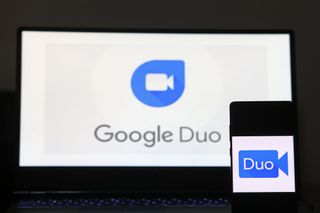Google’s Duo-Meet integration is a confusing way to ‘streamline’ a collaboration service
Business software providers are scrambling to outdo each other and offer everything to everyone, all at once

When the IT Pro team went into lockdown, way back in March 2020, we began reviewing some of the services that enabled us to work remotely. We dived deeply into Zoom, Microsoft Teams, Slack and even Skype. I, myself, went head first into the world of Google Hangouts, the tech giant’s main video conferencing app, at the time.
I liked Hangouts. To be honest, it was all I’d known until Zoom went mainstream. I used it for work and family lockdown quizzes (oh, God, remember those?). I wrote a fairly decent review and a few days after its publication, Google announced Hangouts was to be killed off. Typical.
‘Killed by Google’ is a phrase the company reportedly hates, but it has that very reputation for good reason (Google+ anyone?). However, Hangouts wasn’t wholly getting binned as its capabilities were actually being integrated into Google Chat.
Is this a way for Google to avoid the ‘Killed by’ label? Probably not. Instead, it's actually more about condensing Workspace, the company’s productivity suite formerly known as G Suite, into a less bloated platform.
That, in itself, though, is part of a wider trend to make these cloud-based business apps more holistic, to the point that they no longer need to integrate with other providers: I’m talking here about the new age of vendor lock-in.
It’s a trend we can also see in the metaverse, with each business essentially creating their own virtual realm from scratch.
Hangouts is still there, of course, quite literally hanging out, waiting for its scheduled death in November. And yet, Google is still moving things around, mixing apps together in a bid to find the right balance. The latest change is adding the capabilities of Meet to the Duo app, which will also be rebranded to ‘Meet’. But there’s an odd twist, as, at the same time, the original Google Meet app is still going to be around. Yes, it's all very confusing and needlessly complicated.
Cloud Pro Newsletter
Stay up to date with the latest news and analysis from the world of cloud computing with our twice-weekly newsletter
Eventually, it should all make sense. Duo is an app for making one-to-one calls and Meet is a pure video conferencing platform, so adding them together is a no-brainer. It’s just a bit of a mess in the short term where you’ll have two Meet apps on your desktop. Users that have Duo already installed won’t necessarily have to do anything; the features for Meet have already begun rolling out to Duo and the app icon will change (to Meet) in the coming months. What’s more, anyone who downloads Meet from September will have the combined Duo-Meet version.
You can still use the original Meet app, but enjoy that while you can as it’s clearly headed for the end. Again, Google has managed to avoid the whole ‘killed by Google’ tag here by not technically killing anything as Duo and Meet are simply merging - all that will be lost is the name Duo. When the time comes, Google will prompt users to migrate over, although a specific date hasn’t been disclosed as yet.
These types of tweaks are likely to keep coming as we further navigate the world of hybrid work. To be fair, the way our cloud services look and function has drastically changed since 2020. G Suite is now ‘Workspace’, Gmail is now a hub for more than just email and Office 365 works more like Workspace.
The sudden popularity of video conferencing and collaboration platforms like Zoom and Slack can sort of be blamed here. Their rapid rise almost forced the likes of Google and Microsoft to reinvest in their business apps. Slack, indeed, will have you know that Microsoft Teams is nothing but a poor imitation of its own product. Slack, however, which was taken over by Salesforce is, itself, now trying to position itself as a ‘digital HQ’, a one-stop shop for all you need, with mini video conferencing capabilities and email-like external chat functions.
Slack and Zoom was once a popular pairing for smaller businesses, but the latter is slowly adding Slack-like chat functions. It recently announced Zoom One, a set of business and enterprise tiers that offer more than just video conferencing services. Again, it's about keeping users in one place, under one umbrella. There’s nothing very collaborative about that, now, is there?
Bobby Hellard is ITPro's Reviews Editor and has worked on CloudPro and ChannelPro since 2018. In his time at ITPro, Bobby has covered stories for all the major technology companies, such as Apple, Microsoft, Amazon and Facebook, and regularly attends industry-leading events such as AWS Re:Invent and Google Cloud Next.
Bobby mainly covers hardware reviews, but you will also recognize him as the face of many of our video reviews of laptops and smartphones.





